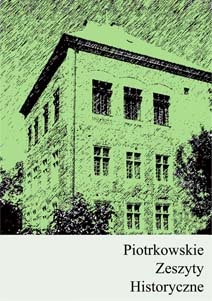Ludność Piotrkowa Trybunalskiego w świetle spisów powszechnych z 30 września 1921 r. i 9 grudnia 1931 r.
Demographic features of Piotrków Trybunalski depicted during national censuses dated on 30th September 1921 and 9th December 1931
Author(s): Michał MichalskiSubject(s): History
Published by: Instytut Historii UJK - Filia w Piotrkowie Trybunalskim
Keywords: demographic features; Piotrkow Trybunalski; history; Poland
Summary/Abstract: Piotrków Trybunalski is a city with a rich history, which was one of the biggest cities of the Lodz District and the most prominent center of administration during the period of the Second Polish Republic. Similarly to the situation observable in the whole country, women constituted the majority of population. Such state of affairs had been caused by war-related undertakings taking place between 1914 and 1920. With time, the demographic situation improved, as increased rate of birth of males was recorded. Moreover, immigrants from other countries stayed in Poland in order to look for a decent job. Two religions were of the biggest importance during that period – Roman-Catholic and Jewish. Nevertheless, through consecutive years, the percentage of the latter decreased in favor of the Roman-Catholics, especially while comparing the demographic situation with that recorded in 1921. In 1931, Polish language was dominant and Yiddish was considered the second most frequently used dialect in the area of the district. During the censuses, almost 60 % of citizens of Piotrków were in their productive age. Such a situation can be easily juxtaposed with the fact that the population was rather young. Taking less prominent factors into consideration, numerous individuals moved from overcrowded villages to the capital of the district to look for a job. What is more, proportions of consecutive age groups were disturbed, as the examination and data gathered during the censuses indicated that older citizens were in minority and constituted a small percentage of the overall population. Thanks to improved education system, citizens of Piotrków Trybunalski were better educated than their peers and relatives living in rural areas. Nevertheless, improper approach to the education issue was still clearly visible, especially during the reign of the Tsar, who had not focused on proper level of schooling in Poland. Therefore, a big percentage of illiterate individuals could be observed, especially in rural areas and in small towns. Such state of affairs was extremely problematic for the local authorities, but numerous corrective actions were undertaken in order to solve the issue. Unfortunately, the main effect of the war-related actions taking place between 1914 and 1920 was a tremendous number of orphans and half-orphans. Numerous children had to grow up without their fathers, as they had died fighting for peace and stability of the surrounding regions.
Journal: Piotrkowskie Zeszyty Historyczne
- Issue Year: 15/2014
- Issue No: 1
- Page Range: 169-200
- Page Count: 32
- Language: Polish

